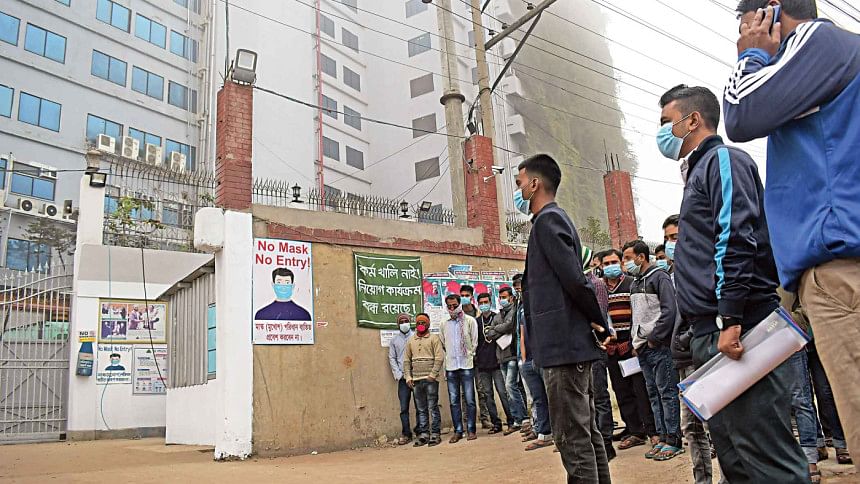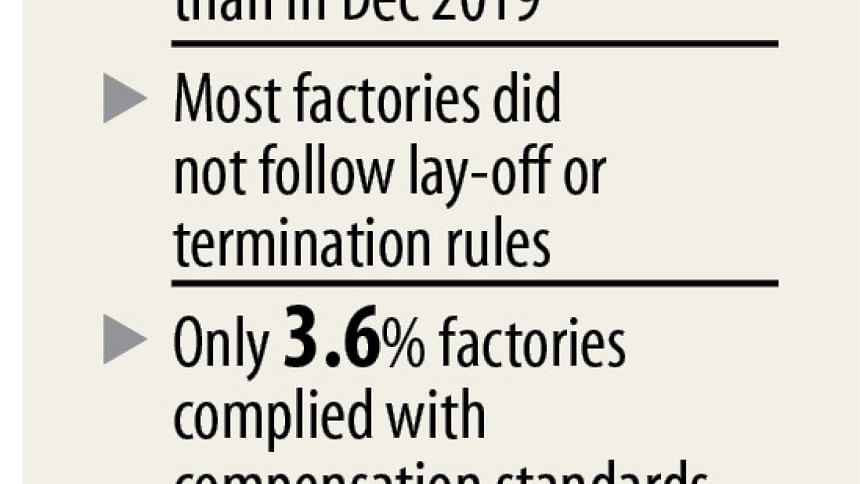Pandemic wipes out 3.57 lakh apparel jobs: study

The coronavirus pandemic wiped out 3.57 lakh jobs in the garment industry in Bangladesh in 2020 as factories went for layoffs and closures because of the collapse in demand, a new study found.
More than 50 per cent factories had fewer workers in September in 2020 compared to what they had in December 2019, said Khondaker Golam Moazzem, research director of the Centre for Policy Dialogue (CPD), during a virtual dialogue yesterday.
The impact caused by the crisis has been so devastating that only 44 per cent factories said they were certain about the work orders for the six months from November 2020 to April 2021.
Some 56 per cent of factories face different levels of uncertainty and 11 per cent indicated high uncertainty, according to the survey of the CPD and the Mapped in Bangladesh (MiB), a project of Brac University.
The outcome of the study was presented during the dialogue on "Vulnerability, Resilience and Recovery in the RMG Sector in view of Covid-19 Pandemic: Findings from the Enterprise Survey".
Out of 3,211 l enterprises listed with the MiB, 610 were surveyed on a sample basis. Of them, 54 per cent are small in size, 40 per cent medium and 6.7 per cent large.
The primary survey was conducted between October and November in four major industrial clusters, namely Dhaka, Gazipur, Narayanganj and Chattogram.
Some 357,450 workers out of 2,562,383 workers covered lost jobs from January to September, about 14 per cent of the total.
The number of workers that were laid off was 2.2 per cent.
"It was informally agreed that the factories that received the stimulus package would not retrench workers," said Moazzem.
Majority of the factories did not follow the layoff and termination rule. Only 3.6 per cent complied with the compensation principle, meaning they paid salary and compensation and cleared dues the CPD said.
About 70 per cent of the factories paid the salaries only. "Non-compliance is much higher in the factories located in Narayanganj and large factories," the think-tank said.
Factories have recruited workers during the pandemic to keep operations running. Thanks to the continued demand for production workers, 58.7 per cent of factories recruited new workers.

The capacity utilisation of the factories improved with the rise in the orders: In April, 89 per cent of factories had zero capacity utilisation, which came to down 1.3 per cent in September.
Due to the pandemic, the size of factories has scaled down. The average number of workers in a factory in December 2019 was 886, and it came down to 790 in September last year, a fall of 10.8 per cent.
Speaking at the virtual dialogue, Rehman Sobhan, chairman of the CPD, said under the current business model, most of the burden was borne by the supplying countries, and the buyers were risk-free.
There is a lack of information on how a $2 shirt is sold at $20 by international retailers and brands, he said, suggesting research firms conduct studies on this particular issue.
He suggested introducing a general comprehensive insurance programme in the garment sector. The government, buyers, donor agencies and workers should participate in the programme.
Mohammad Abdul Momen, director of the Bangladesh Garment Manufacturers and Exporters Association (BGMEA), said the moment the garment sector was trying to recover from the fallouts of the Covid-19, the second wave hit.
During the first wave, 99.99 per cent of retail outlets were shut. It is 25 per cent during the second wave, he said.
The prices of raw materials like yarn and cotton have gone up, but the prices of garment items did not increase. Rather, it decreased by nearly 15 per cent, the entrepreneur said.
Mohammad Hatem, first vice-president of the Bangladesh Knitwear Manufacturers and Exporters Association (BKMEA), said local suppliers faced discounts between 25 per cent and 50 per cent from buyers, not only just the cut in prices.
"We have started recruiting workers as orders are flowing in. We are suffering from the shortage of workers again," he said.
He said 80 per cent of factories were running at losses and they had kept their business up and running just to survive.
"Ten per cent of factories are running at break-even and 10 per cent large units are making some profit."
Of the more than 850 members of the BKMEA, 420 availed loans from the stimulus package. Some 99 did not receive the loan although they had applied.
The CPD study said it was alleged that factories that recruited new workers had mostly hired their retrenched workers but at a downgraded level. This means they were offered lower grades, lower pay and were hired on a contractual basis.
Though workers got the job, they lost entitled benefits due to discontinuation of their jobs, it said.
The think-tank said the subsidised credit provided under the stimulus package and the gradual rise of production orders helped factories to address the crisis.
The package covered the demand of 70 per cent of the enterprises. However, about 30 per cent of the enterprises were left out of the package. They include small and non-member factories.
Any future package for the sector needs to be customised considering the priorities to small scale enterprises and non-member enterprises, the CPD said.
Kutub Uddin Ahmed, former secretary-general of IndustriALL Bangladesh Council, said the income of garment workers declined by 8 per cent during the pandemic.
He said the fund given by the European Union and Germany for the retrenched workers could not be disbursed because of faulty lists supplied by the BGMEA and the BKMEA.
Syed Hasibuddin Hussain, project manager of MiB, moderated the meeting.

 For all latest news, follow The Daily Star's Google News channel.
For all latest news, follow The Daily Star's Google News channel. 



Comments